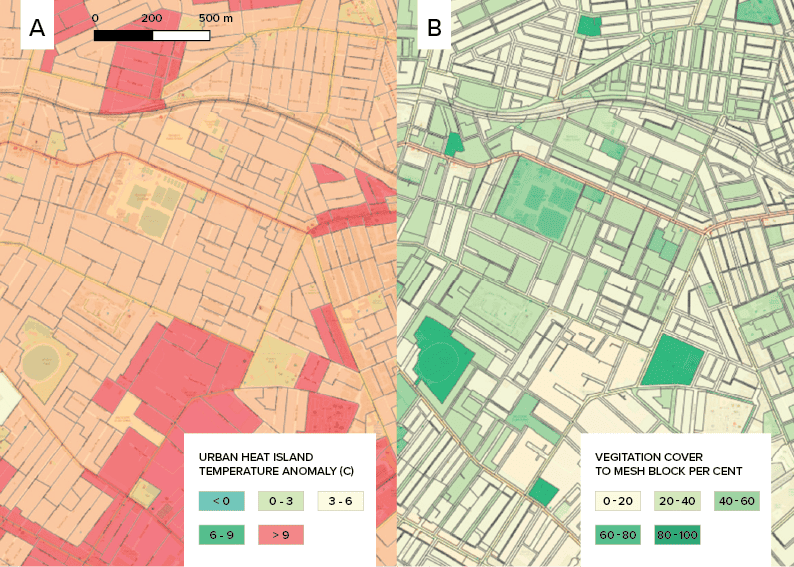
Bringing Together Bushfire History Data to Plan for the Future
Exploreabout Bringing Together Bushfire History Data to Plan for the Future
A 2020 study by Curtin University’s Dr Ivan Hanigan and colleagues1, found that every year about 2,600 Australians die prematurely from human-caused air pollution — including from particulate matter, carbon monoxide, ozone and ultrafine particles. The reduction in life expectancy has been costed at around $6.2 billion annually, measured in terms of a dollar value assigned to each person’s potential years of life lost.
To reduce the impact of these emissions on people’s health, policymakers need to make evidence-based decisions to reduce air pollution in areas such as urban planning and planning prescribed burns for bushfire management. Recent ARDC supported research has improved access to air pollution and health data and tools to better quantify how environmental changes affect people’s health, and enable environment and health agencies to better understand the likely impact of proposed interventions to address the problem.
Part of the challenge is the restricted access to health data at a local level. For ethical reasons, people’s health records are protected by several layers of data security and confidentiality requirements.
Also, air pollution reporting standards vary by state and territory. And it’s difficult to consolidate and integrate air pollution and health datasets for use in computer models that quantify air pollution exposures —which is what is needed to inform policy changes and reduce human health impacts.
“A major hurdle to more accurate quantification of the health burden due to air pollution is obtaining appropriate mortality data, which can be difficult to access even for governments,” said Dr Aditya Vyas, Deputy Director of the WHO Collaborating Centre for Climate Change and Health Impact Assessment at Curtin University. “The other challenge is making those data available so that it becomes knowledge, which can in turn be used practically by policymakers to benefit society.”
With support from the ARDC, Dr Hanigan from Curtin University and Professor Geoff Morgan from The University of Sydney coordinated a project to develop the Integrated National Air Pollution and Health Data platform.
Launched in mid-2023, the platform brings together data about the environment, pollution, health and mortality across time, place, type and source. It gives researchers access to restricted but de-identified health data to estimate risk and numbers of deaths attributable to human-caused air pollution emissions. Importantly, researchers and decision-makers can see the likely impact on mortality of reducing these emissions. This information can inform changes in economic and environmental policies to create sustainable cities and environments.
The ARDC-supported project team worked closely with researchers and the AIHW to summarise or aggregate confidential mortality data for the new platform. The summarised or aggregated data enables more accurate quantification of the health burden due to air pollution while maintaining the confidentiality of individuals’ data.
The platform standardises past and current air pollution observations from around Australia, including for particulate matter, carbon monoxide, ozone and nitrogen dioxide. These data feed into epidemiological modelling of air pollution exposure and mortality.
“The ARDC encouraged everyone to be more systematic,” said Dr Hanigan. “With their support, the research and policy translation community can reduce the time taken to acquire relevant health data for standardised processes such as air pollution health impact assessment, while maintaining health data confidentiality and security. The creation and storage of data on a platform will reduce time spent on data grunt work.”
As an example, the new platform has been used to find ways to reduce heat-related deaths in cities by reducing the so-called urban heat-island effect2.
Air temperature observations aggregated from a range of agencies, combined with modelled results of the excess heat from cities, can be linked with downscaled health data and seasonal trends in death rates. From this, the number of deaths attributable to the urban heat-island effect can be estimated. This number could be projected forward to show the likely future mortality from heat in cities, under continued global warming.
An added bonus, said Dr Hanigan, is that “through the platform, we can share the results, heat maps, and other analyses without requiring IT support or expensive software.”

Using the new platform to analyse data about drought exposure combined with the number of rural suicides has already revealed an increase in rural suicides during drought.
“We found, on average each year, 1.8 per cent of suicides among men in Australia’s rural communities can be attributed to drought,” said Dr Vyas.
“Under climate change, we will see more drought in Australia, with models suggesting drought-related suicides will increase to 3.3 per cent.”
These results suggest an urgent need for actions to adapt to climate change and drought to avoid impacts on vulnerable communities.3

Dr Hanigan envisages the platform will enable a more resilient society.
“This technology will enable people to rapidly map the impacts of climate hazards such as bushfires, heatwaves and floods, and potentially preempt them to give near-real-time health warnings,” he said.
“And the platform’s ability to show the impact of data on decisions may lead to more proactive evidence-based policies that help mitigate future climate change and justify investment in mitigation activities.”
Dr Vyas agrees. “Outputs from this will be considered by policymakers responding and adapting to climate change,” he said. “In addition, the international focus of our work means we can translate the infrastructure, methods, tools and technology for other countries, to have even more impact.”
This project received co-investment (doi.org/10.47486/PS022) from the ARDC. It is led by Curtin University in partnership with The University of Sydney, Monash University, The University of Queensland, Australian Institute of Health and Welfare (AIHW), Department of Planning and Environment NSW, CAR and Environment Protection Authority Victoria.
Written by Simon Torok, Scientell. Reviewed by Jo Savill (ARDC), and Ivan Hanigan and Aditya Vyas (Curtin University), Assoc. Prof. Geoff Morgan (University of Sydney).
1 Avoidable mortality attributable to anthropogenic fine particulate matter (PM2.5) in Australia. DOI: 10.3390/ijerph18010254
2 Mortality burden attributable to exceptional PM2.5 air pollution events in Australian cities: A health impact assessment. DOI: 10.1016/j.heliyon.2024.e24532
3 Climate Change, Drought and Rural Suicide in New South Wales, Australia: Future Impact Scenario Projections to 2099. DOI: 10.3390/ijerph19137855